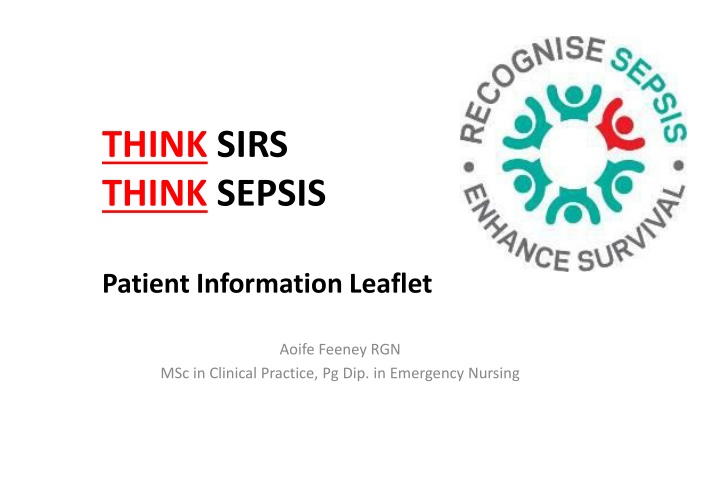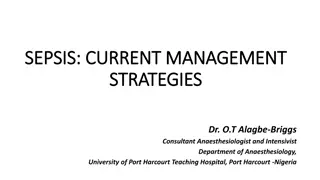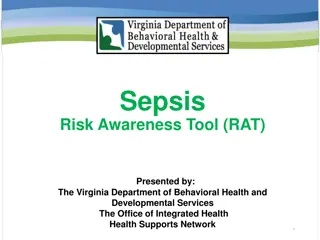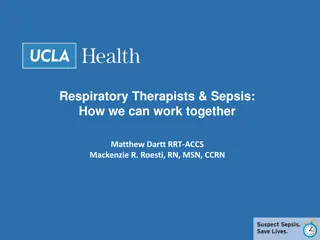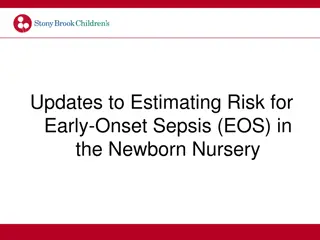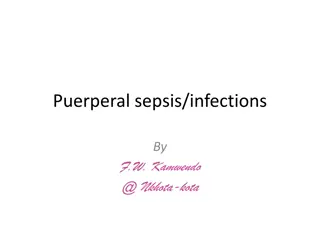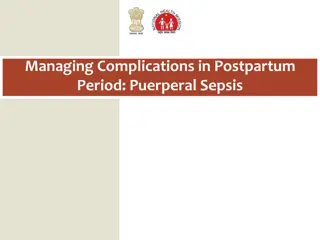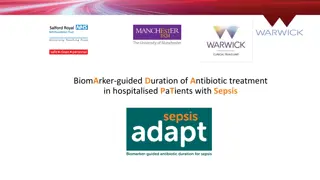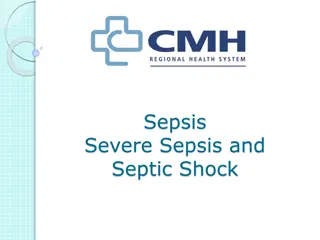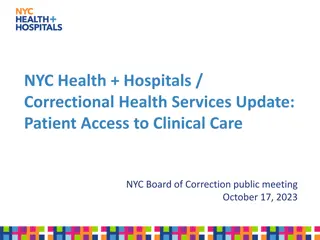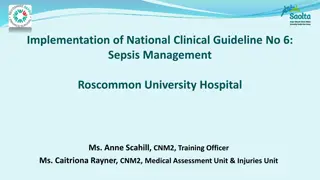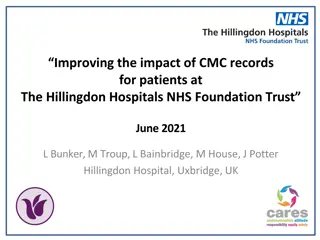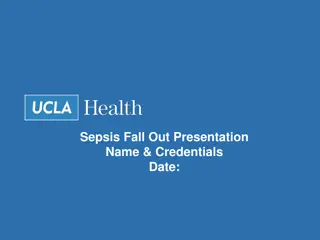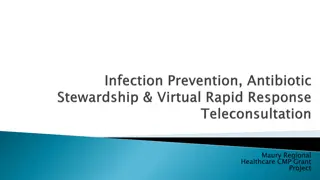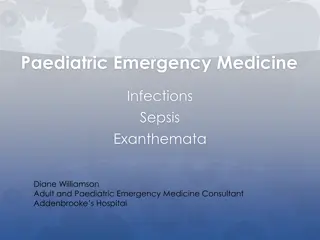Improving Sepsis Awareness: A Patient Information Initiative
This content delves into strategies to enhance public awareness of sepsis, aiming to provide informative leaflets to patients during discharge from the Emergency Department. It discusses the importance of recognizing sepsis symptoms and outlines a conceptual plan to educate both patients and healthcare staff effectively. The initiative focuses on promoting wellness, offering evidence-based information, and increasing self-awareness through user-friendly resources. Moreover, it highlights the key signs of sepsis and emphasizes the need for timely intervention to improve patient outcomes.
Download Presentation

Please find below an Image/Link to download the presentation.
The content on the website is provided AS IS for your information and personal use only. It may not be sold, licensed, or shared on other websites without obtaining consent from the author.If you encounter any issues during the download, it is possible that the publisher has removed the file from their server.
You are allowed to download the files provided on this website for personal or commercial use, subject to the condition that they are used lawfully. All files are the property of their respective owners.
The content on the website is provided AS IS for your information and personal use only. It may not be sold, licensed, or shared on other websites without obtaining consent from the author.
E N D
Presentation Transcript
THINK SIRS THINK SEPSIS Patient Information Leaflet Aoife Feeney RGN MSc in Clinical Practice, Pg Dip. in Emergency Nursing
EBOLA IS UNCOMMON IN THE USA, YET MORE ADULTS HAVE HEARD OF IT THAN SEPSIS Never Heard of % Condition At Least Somewhat Aware % Never Heard of/Just heard the name % Cancer 97 1 3 96 1 4 Diabetes AIDS 93 1 7 96 2 Alzheimer s Malaria 7 14 24 26 29 50 53 74 76 77 Ebola 86 76 2 4 6 11 35 32 46 64 66 74 ALS COPD 71 50 47 26 MRSA Sepsis Dengue Fever Fever CDiff Necrotising Fasciitis 24 23 14 Sepsis Alliance conducted by Harris Poll June 2015
Measurement Global Aim To improve publics awareness of sepsis Global Aim Process begins from the time the patient registers in ED to the time the patient is discharged from hospital. By working on this process it is expected that i)increased awareness of sepsis to patient s and staff ii) reemphasis on assessment and management of sepsis iv) thus timely access to tx iii) increased pt & staff satisfaction. It is NB to work on this now in order to improve outcomes for our patients Abstract The big picture Specific Aim the components part Specific Aim To improve the quality of information that patients receive on sepsis care from been a significant problem to a leaflet that all patients should receive on discharge from ED. The aim is to improve this problem within 6/12 Change Ideas Change Ideas design a patient information leaflet, partner with ICU,NPDU for Sepsis September highlight awareness to staff. ED on registration pts/relatives were given sepsis literature, Nursing and medical educational sessions re secondary sepsis triage, time to IVAB/IVF, lactate what will you do Conceptual Definition Conceptual Definition Ongoing ED survey to identify the public s level of knowledge re sepsis . PDSA cycle Plan, Do, Study, Act What will you measure Concrete Operational Definition Auditing of the ED, pre and post introduction of the patient information leaflet. The data collection sheets will be collected daily and correlated onto a run chart. The findings pre and post will be displayed to ED staff Operational definition
Information Leaflet Promote Wellness Offer health lifestyle choices Evidence based research Increase self awareness Patient Information Leaflet User and reader friendly Resourceful Eye catching WOW Factor
How do I know if I or a loved one has sepsis? If you think that you, or someone close to you, has an infection AND is experiencing some of the following signs, you are at risk of sepsis. S ? Slurred speech, confusion,weak SEPSISis Fast heartbeat, fast breathing, insufficent urine I Heartbeat is more than 90 beats a minute. Breathing is more than 20 breaths a minute. Passing very little urine, or passing urine that is dark and smells bad. infection + SIRS symptoms (Systemic Inflammatory Response Syndrome) Slurred speech, confusion,exhaustion Increased heartrate, breathing, not enough urine Rigors (severe shivering and fever) or chills Skin colour changes (causing widespread inflammation) R Rigors, chills Severe shivering and high temperature Skin colour changes S Skin is cold, pale, mottled or warm and flushed Should I call for help? Yes. Call your family doctor (G.P.) or nurse immediately. Ifthey cannot see you, go to your nearest hospitalemergency department. IF YOU HAVE INFECTION AND FEEL VERY UNWELL SUSPECT SEPSIS SEEK URGENT MEDICAL ADVICE REMEMBER Suspect SEPSIS - seek urgent medicaladvice For more information go to www.hse.ie/sepsis
What is sepsis? Sepsis is a severe infection affecting the whole body. It can cause serious illness and even death. It is vital to get early treatment ifyou think you, or a loved one, might have sepsis. Most common sources of infection: Sepsis is only diagnosed if infection is suspected or proven to be the cause of these signs. As sepsis is often hard to diagnose in the early stages, it is really important to watch for the signs of severe sepsis which might develop if the infection is not treated early or is not responding to the initial treatment. Is sepsis common? Who is at risk? Sepsis is very common but because it is often just labelled as infection it is not well discussed. Anyone can develop sepsis but it is more likely to develop in: people who have recently had surgery or who have wounds or injuries from accidents; people receivingtreatments which weaken the immune system, such as steroids or chemotherapy (cancer) treatment; patients who have urinary catheters (a tube in the bladder to help pass urine) or intravenous devices (such as drips going into a vein). What is severe sepsis? babies, especially premature babies; frail, older people; In severe sepsis there is huge damage to the body. The immune system is either not working properly or can t cope and the body s organs (such as the heart, kidneys and liver) are damaged, and begin to shut down. In fact more people die of sepsis than lung cancer, breast cancer and HIV/AIDS combined. It is becoming more common due to: increased use of antibiotics leading to germs that are resistant to antibiotics; more patients living with weakened immune systems. 42% Respiratory (lung) 23% Urinary tract (kidney and bladder) 18% Abdominal (for example, if thereis an collection of pus in the abdomendue to a burst appendix, hole in the intestine or as a complication after surgery) people living longer; Other What is septic shock? 12% Catheter related blood streaminfection 3% Septic shock happens when sepsis has reached the point where there is a life- threatening drop in blood flow to the vital organs. (large drip that stays in the vein for people on long-termtreatment ) 1% Device such as a urinary catheter or pacemaker or otherforeign object in the body What are the signs of severe sepsis and septic shock? Brain and spinal cord such as meningitis What causes sepsis? 1% (Sourced from IMPRESS Trial, 2014) Every year, millions of people develop local infections such as flu, gastroenteritis (vomiting and diarrhoea) or other viruses. Normally, the body recognises the infection, such as the bacteria or virus, and starts trying to remove the infection and allow the body to heal. INFECTION Marked confusion, slurred speech, extreme weakness,inability to feed Difficulty breathing Very fast heart rate Passing little or no urine, or passing very dark urine with a bad smell Cold, clammy, pale or mottled (blotchy) skin Rash Adolescents may describe severe leg pain and indeed may have trouble standing I feel like I might die ` What are the signs of sepsis? The early signs of sepsis are: high temperature > 38.3 C, and/or rigors, (shivering fits and chills) fast heart rate, > 90 beats per minute fast breathing rate, > 20 breaths per minute confusion, especially in very old people lethargy (weakness) and poor babies and young children However, many other illnesses and conditions can also cause these signs. SEPSIS Sepsis happens when the local infection spreads throughout the body. The body temperature rises to try and stop the germs multiplying and the body makes more white blood cells to find and kill the germs. This is called the inflammatory response . feeding in SIRS (symptoms)
Short Term-Medium Goals Determine current awareness of sepsis locally Explore the public s perception of sepsis Disseminate the Findings Implementation locally...aim to hospital wide Re-audit /survey of the leaflet Long Term Goals.. Determine the awareness of sepsis nationally Explore how Ireland defines sepsis Implementation nationally Re-audit
